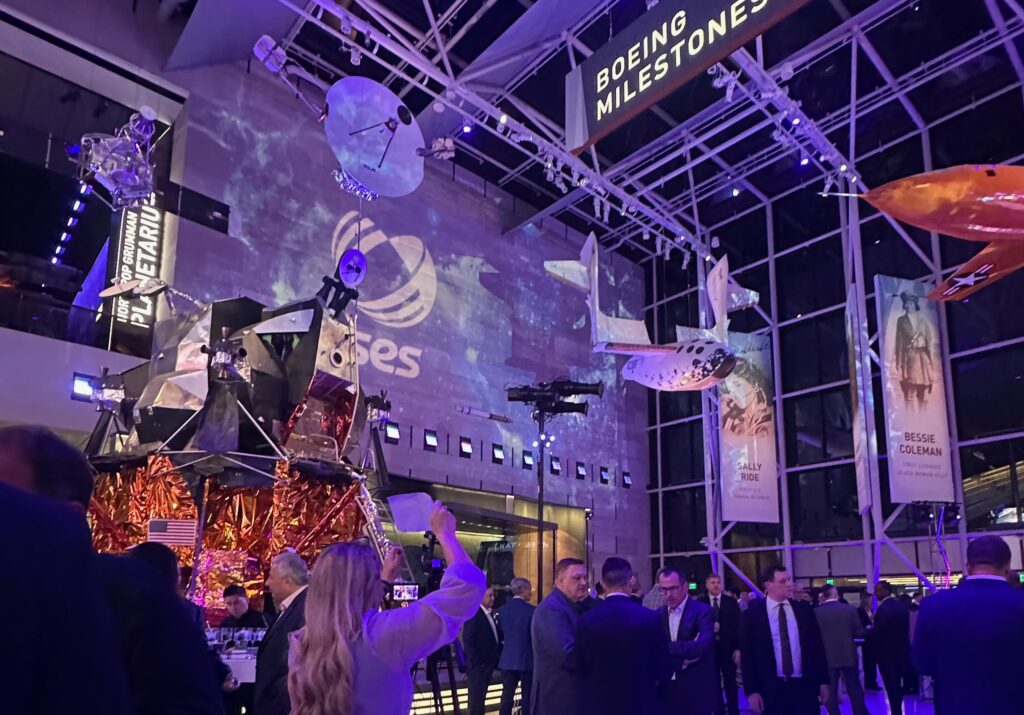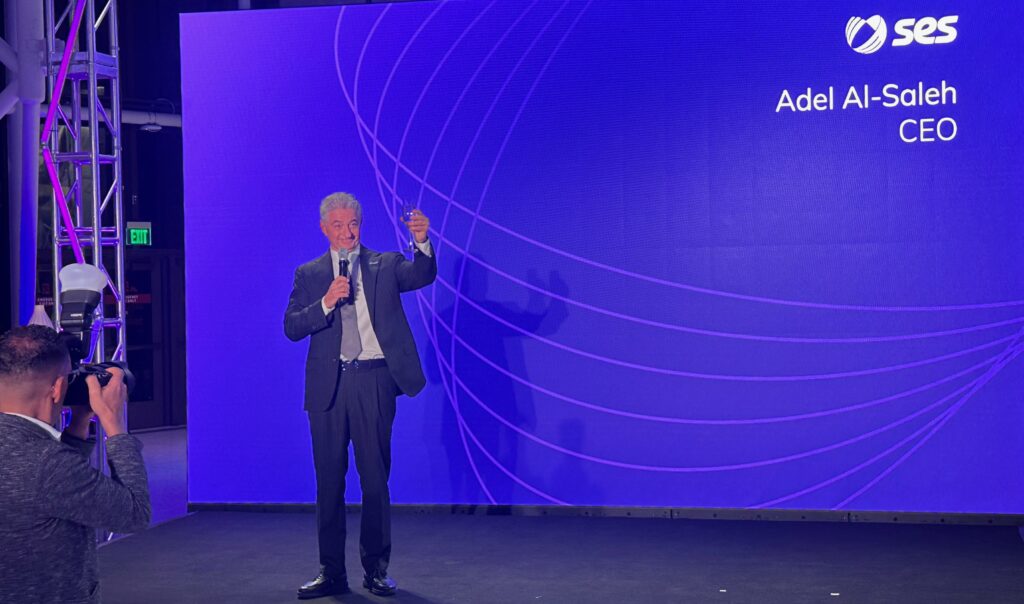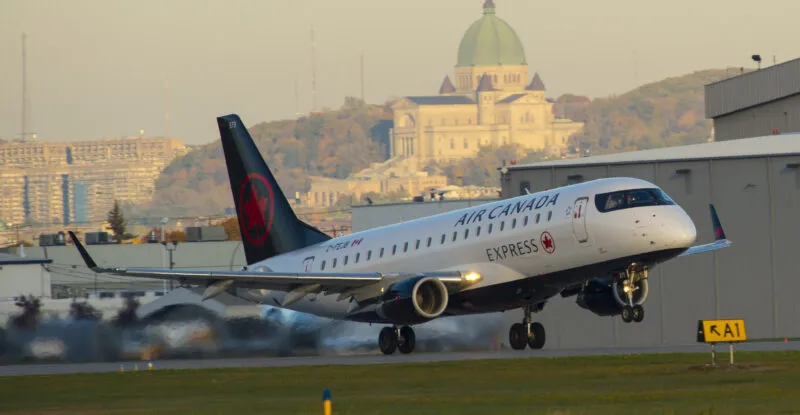WASHINGTON D.C. — Air Canada has fielded extremely positive feedback from guests who have flown aboard the 30 CRJ900s now equipped with SES’s electronically steerable antenna (ESA)-based Ku-band multi-orbit inflight connectivity solution, which supports free Wi-Fi for its loyalty members on the regional jets. Now the Star Alliance member is gearing up to begin installs on its 25-strong Embraer 175 fleet.
Supplemental type certification for the E175 “should be approved hopefully by the end of this month or early next month,” Air Canada manager inflight Wi-Fi and analytics, André Patrick told Runway Girl Network at the National Air and Space Museum in Washington D.C., where SES joined its customers, partners and employees in celebrating its recent acquisition of satellite operator and aero ISP Intelsat, and subsequent rebrand.
“And then once the STC is approved, we’ll start installing rapidly,” Patrick said of the E175 fleet. “Hopefully by the end of this year or early next, that will be complete.”

SES celebrated its rebrand with customers, employees and partners at the National Air and Space Museum. Image: Mary Kirby
“Customers are loving it; crew more importantly are also loving it,” Patrick said of the Bell-sponsored free Wi-Fi aboard Air Canada’s CRJ900s.
The SES inflight connectivity system aboard these RJs is supported by both the Eutelsat OneWeb Low Earth Orbit (LEO) satellite network — for which SES is now an aero distribution partner through its Intelsat buy — and SES’s Ku-band geostationary (GEO) satellites, a portfolio which has grown leaps and bounds now that Intelsat is under its wing.
Patrick revealed:
The feedback from crew is that no customers are complaining; that they like the experience, and they can do what they want to do on the aircraft compared to what we previously had, which was our legacy ATG service.
Customers on the CRJ900s are largely experiencing the connectivity over the LEO network as opposed to GEO. Low-latency LEO is primary, including when aircraft are on the ground at Air Canada’s hubs, Patrick confirmed to RGN. GEO kicks in “as a backup or failsafe, if something happens to LEO. So, from gate to gate we strive for LEO but then we have the redundancy of GEO as a fallback.”
That redundancy and resiliency gives Air Canada greater confidence that it can make good on its commitment to provide free Wi-Fi to loyalty members. “Blackouts happen. It doesn’t matter who the provider is, it happens to all of them. We see that multi-orbit gives us that flexibility and keeps our customers connected,” said the Air Canada executive. (It is perhaps notable that Air Canada won’t have that failsafe when it flips the switch on SpaceX’s Starlink LEO service aboard the cluster of Jazz Aviation-operated Q400 turboprops earmarked for that IFC system.)

To date, Air Canada has fitted 30 CRJ900s with the SES multi-orbit IFC system. The ESA hardware is supplied by Gilat, formerly Stellar Blu. Image: Jason Rabinowitz
Also of note: when GEO satellites are in play, and powering Wi-Fi on Air Canada’s CRJ900s, they are delivering a better experience than in the past, Patrick said. That’s because Air Canada is working closely with SES to configure the network in a manner that ensures latency is lower. “We’re doing a few things in the backend, cutting down some of those milliseconds to give passengers a better experience.”
Quvia — the first AI-powered Quality of Experience (QoE) platform for commercial aviation, and a partner to SES — is also assisting Air Canada by providing real-time visibility into the performance of the carrier’s entire IFC-equipped fleet, including mainline aircraft that are fitted with SES-formerly-Intelsat’s 2Ku GEO-focused IFC solution. Patrick explained:
It shows us as an airline what’s working, what’s not working — packet loss, latency, and QoE on the web level. So, what we like about it is we’re taking that data, and we’re working with SES to understand what’s happening. We have real-time escalation, and we don’t have to wait until our customer complains about it when they’re on the ground through customer relations four days later. We don’t have to wait for our service provider to run an analysis and four days later, as an example, tell us what the root cause analysis was. We know in real time there’s a problem.
Quvia also provides a trend report so we know at a root level or an aircraft level what’s happening over time to say, ‘this aircraft has some component that might be failing because the QoE is low, or this route for some reason always drops Wi-Fi in this region, why is that?’ So, we can dive into that with our service provider.”
Formerly known as Neuron, Quvia is certainly on the march in aviation; it also counts Delta and JetBlue amongst its roster of aero customers. And it has a large footprint in the maritime industry.
Air Canada’s 2Ku-fitted mainline fleet also benefits from Quvia’s insights and analysis. An updated version of 2Ku, which is based on ThinKom Solutions’ Ku3030 VICTS antenna hardware, is now flying at Air Canada, and supporting its Bell-sponsored free Wi-Fi. But, as Patrick revealed to RGN earlier this year at the SATELLITE 2025 conference, Air Canada is also eyeing the possibility of adding a LEO-only ESA to these aircraft.
“We’re exploring what the options look like, what the tech looks like, what the commercials look like, what everything looks like across the board, and does it work for the business,” he reaffirmed last night in Washington D.C.
During the event, Adel Al-Saleh, the CEO of SES, declared that the Luxembourg-based firm has entered “a new chapter” after completing its acquisition of McLean, Virginia-based Intelsat on 17 July. Together, the two companies have a combined 100-year history, and “we’re going to leverage that history to create something very, very different.”
“The combination,” he said, “gives us many opportunities” including in support of government missions for the United States — for which it has an “unwavering commitment” — as well as allied forces around the world, especially NATO.

Adel Al-Saleh, the CEO of SES, raised a glass to toast the firm’s rebrand alongside its partners, customers and employees. Image: Mary Kirby
SES plays a large role in many other industries. It supports connectivity for “30 airlines around the world” including airlines that have adopted GEO-, MEO/GEO- and LEO/GEO-based IFC solutions, as well as “nine of the ten biggest cruise lines” and “more than 14,000 connections with commercial shipping,” Al Saleh noted.
“So, a company combination creates something very unique and very different. One thing that’s different about us is the multi-orbit capability. We manage 120 satellites, 90 to 100 of GEO satellites, and then we’re the only commercial company that has a complete fleet of MEO satellites. And we partner, together with our partners, to provide our customers with the LEO connectivity as well when it’s required. So we provide something unique.”
On top of its satellite capabilities, SES has one of the largest ground infrastructures around the globe, managing more than 600,000 kilometers of fiber. “Now from a customer perspective, we bring all these capabilities together to solve some of the most difficult problems that they have,” Al-Saleh said. “We try to make usage of space easy, consumption of space easy.
“For our partners, we created now a company that will continuously invest. We’re a company that is committed to continue to build our networks, both in space and on the ground, and we’re a partner that can work together with our partners to develop these offerings for our clients.”
SES decided to rebrand because it wanted to have a different identity, he explained. Its new tagline, “solve, empower, soar” represents SES’s culture, its psyche and how it drives its business.
“We want to solve problems. We want to solve challenges for our customers. We want to empower our employees, our engineers, our customers, to do the best that they can. And we want to be better every day. We want to make sure that we enable our clients to grow and to deliver on their business commitments and business objectives that they have.”
The new brand design is now on display at SES’s offices in McLean. And it will debut as part of a new purple-and-white-hued livery on the firm’s CRJ testbed aircraft.

SES is putting the finishing touches on its new livery for the CRJ. Image: Mary Kirby
Related Articles:
- SES on track to have 600 aircraft fitted with ESA IFC by year-end
- Blazing fast Internet on an RJ? Air Canada stuns in free Wi-Fi rollout
- Air Canada taps Starlnk for some Q400s as part of redesign
- SES completes Intelsat buy with FCC blessing
- Network resiliency in the spotlight after Starlink outage
- Q&A with Norman Haughton as Air Canada preps to offer free Wi-Fi
- Different eras: trying Air Canada’s oldest and newest cabins
Featured image credited to SES












